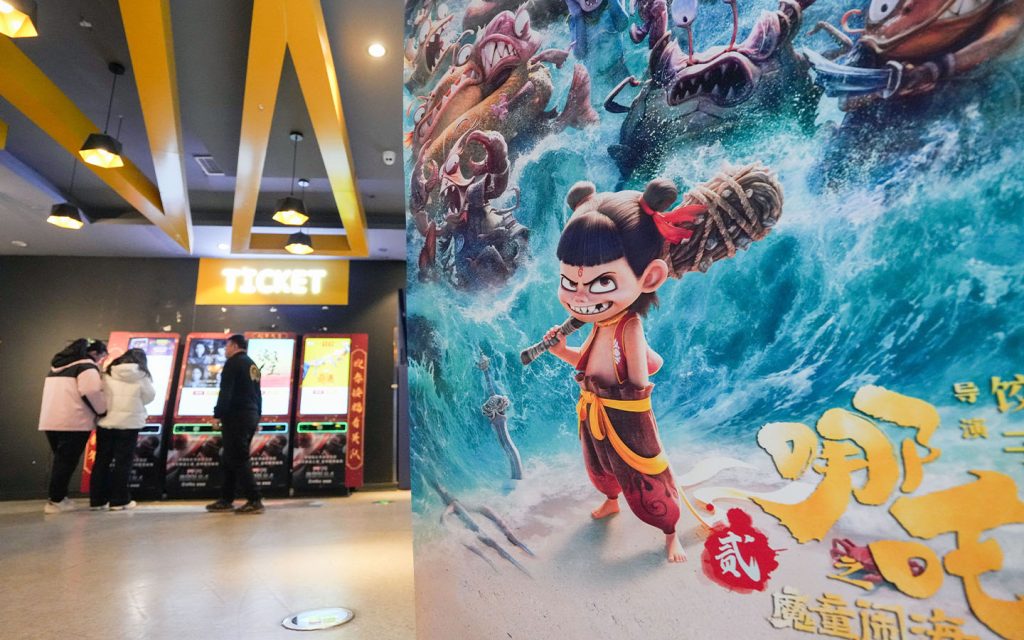The deity Ne Zha has long been part of the Chinese popular consciousness, but it was the release of the animated film Ne Zha (2019) and its sequel, Ne Zha 2 (2025) that brought the mythological character’s national and global profile to dizzying new heights.
Since its premiere in China on 29 January, Ne Zha 2 has broken multiple film records, attracting world media attention in a way that very few other Chinese films have managed to achieve. In a little over eight days, the fantasy-adventure flick managed to become the first film in history to break US$1 billion in a single market. It followed this up on 19 February by eclipsing the US$1.68 billion grossed by Inside Out 2 to clinch the title of the highest-grossing animated film of all time.
[See more: A Chinese film has become the first ever to gross US$1 billion in a single market]
As of writing, Ne Zha 2 was ranked as the 8th highest grossing movie in history, with a worldwide box office taking of more than US$1.9 billion, putting it above The Lion King and Jurassic World, which earned US$1.65 billion and US$1.67 billion respectively. The film shows no signs of slowing down anytime soon, with ticketing platform Maoyan forecasting a total gross of around US$2.08 billion.
Ne Zha 2 is the tale of a demon child
Successful animated features are hardly an anomaly in Chinese cinema, with the past decade having seen hits such as Monkey King: Hero is Back (2015), White Snake (2019) and Chang’an (2023). Much like these box office successes, Ne Zha 2 is deeply rooted in traditional Chinese culture and legends, loosely adapting the two-volume 16th century Chinese novel called Investiture of the Gods (封神演義, Fengshen Yanyi).
In this sequel, the story picks up immediately after the events of the first installment, which left the souls of the demon boy, Ne Zha, and his friend, the dragon prince Ao Bing, without physical bodies.
The two characters manage to attain new ones with the help of Ne Zha’s mentor, Taiyi Zhenren, but Ao Bing loses his body not long afterwards following a short-lived battle between his father, the dragon king, Ao Guang, and the inhabitants of Ne Zha’s hometown.
Eager to help his friend, and to prevent the town from being destroyed by Ao Guang, Ne Zha and the spirit of Ao Bing – who are now forced to share one body – undergo a three-round exam from the immortal Wuliang Xianweng, in order to attain a potion that will restore Ao Bing’s physical form.

The animation Ne Zha 2 adapts Chinese mythology for the 21st century
Convoluted is one way to describe the plot of Ne Zha 2, although this must be understood in the context of its source material, which reimagines the turbulent transition from the Shang Dynasty to the Zhou Dynasty through a rich tapestry of characters from Chinese folklore and history, who each have their own unique backstories.
Despite the dense nature of the original novel, Hong Yanyan, a doctoral film researcher at the University of Adelaide, believes that the movie, which weaves an entirely new storyline for Ne Zha, can still be enjoyed by those who are not knowledgeable about Investiture of the Gods.
“It injects fresh energy, modern themes, and new perspectives into traditional mythology, which help bridge the gap between generations or sometimes nations,” she points out.
The academic concedes that the animated feature “may not be for everyone” due to “its potty jokes and intense action sequences,” although she personally enjoyed the film, as it reinterprets Ne Zha, a beloved character that Chinese people grew up with “in such a bold and visually stunning way.”
Indeed, the character of Ne Zha has evolved radically over the ages from his origins as a Hindu mythological figure to a tragic child-hero in Chinese folklore, who has a complex relationship with his father. In the current franchise, the character has once again been updated, turning into a rebel who loves his family and attempts to chart his own path in life.
Reasons behind the success of Ne Zha 2
Regarding the film’s phenomenal success in China, Hong points to several factors, and aptly quotes the Chinese saying “天時地利人和,” (tiān shí dì lì rén hé), which like its counterparts in other languages, means “it had the right timing, the right place and the right audience.”
The scholar explains that the decision to release Ne Zha 2 during the Lunar New Year worked in its favour, as the holiday period allowed families to hit the theatre. Coupled with “a strong word-of-mouth,” “state media coverage” and “a solid, entertaining story” that one-upped its predecessor in terms of visual spectacle, the film’s popularity began to snowball.
While Ne Zha 2 has largely drawn almost the entirety of its box office earnings from mainland Chinese audiences, the movie has also managed to gain traction overseas, with its global receipts already crossing the US$13 million mark, following its debut in countries such as Australia and the US earlier this month.
On whether or not non-Chinese audiences will be able to appreciate Ne Zha 2, Hong says that it will come down to “their openness to different storytelling styles” and “their familiarity with Chinese culture,” as the film is underpinned by Chinese mythology and philosophical concepts such as Taoism, Confucianism and Buddhism that sets it apart.
The film expert however remains confident that the animated feature’s “strong visuals and universal themes of rebellion, identity and destiny” give it “the potential to connect with global audiences over time.”
The story of Jiaozi and the influences on Ne Zha 2
For director Yang Yu, who is better known by his professional name Jiaozi (Dumpling), the historic success of Ne Zha and its sequel is a far cry from his early days as a struggling animator.
Born in Luzhou, Sichuan province, the 45-year old was originally set to follow in the footsteps of his doctor parents, studying medicine at the Sichuan University’s renowned West China School of Pharmacy. Yang, however, found his true calling in animation, a field that he had been interested in since childhood.
Upon graduation, Yang went on to work for an advertising agency and spent his free time self-studying animation. Unable to contain his passion, the aspiring talent resigned from his job with the support of his parents and devoted his energies to breaking into the industry. This period would prove to be a trying time for Yang, as his father passed away, and he and his mother were forced to get by on her measly monthly income of 1,000 yuan for the next three years.
The year 2009 was a breakthrough for the animator, as he released See Through, a 16-minute anti-war film with no dialogue, which garnered over ten million online views, as well as many awards. The attention that this animated short attracted helped Yang earn recognition, paving the way for his selection as the director of the Ne Zha franchise.
While Yang is an integral part of Ne Zha, the series’ success runs much deeper than simply the story of one man. As Hong notes, “Ne Zha 2 represents a new generation of Chinese filmmakers and animators – people who grew up watching Hollywood, Japanese anime, Hong Kong, and classic Chinese stories – all coming together to create something modern and uniquely their own.”

The diverse range of global films that have inspired modern Chinese animated films has, however, been lost among some Chinese audience members who view the success of Ne Zha 2 purely from the lens of national pride and rivalry with Hollywood.
In reality, Ne Zha 2 pays tribute to a range of different overseas productions that came before it, with its fight scenes featuring all the hallmarks of anime such as Dragon Ball Z and Saint Seiya. Meanwhile, its emotional moments are reminiscent of those from Pixar films such as the Toy Story series (1995-present) and Soul (2020).
Yang himself is not shy about his international influences, as the credits of his short film, See Through, listed his eclectic list of “idols,” which includes Japanese animation maestros Osamu Tezuka and Hayao Miyazaki; US studios Disney and Pixar, and Chinese performers Jackie Chan, Stephen Chow and Jet Li.
Hong sums it up best: “Ne Zha 2 wasn’t intended to challenge or compete with Hollywood, Japan or [the like]. It was made to inspire and push Chinese animation forward. Its success shows that Chinese audiences are eager to see their own stories told on a grand scale, and that’s something to be proud of.”
Ne Zha 2 held its premiere in Macao on 20 February and is currently screening across all major local theatres (excluding Cinematheque Passion) following its general release on 22 February.






